ActiveOutdoorsA beginner’s guide to scrambling: expert tips for getting startedWhat is scrambling? And what is roped scrambling? We asked a mountain guide to explainWhen you purchase through links on our site, we may earn an affiliate commission.Here’s how it works.
ActiveOutdoorsA beginner’s guide to scrambling: expert tips for getting startedWhat is scrambling? And what is roped scrambling? We asked a mountain guide to explainWhen you purchase through links on our site, we may earn an affiliate commission.Here’s how it works.
What is scrambling? And what is roped scrambling? We asked a mountain guide to explain
When you purchase through links on our site, we may earn an affiliate commission.Here’s how it works.
(Image credit: Adrian Nelhams / ISM)
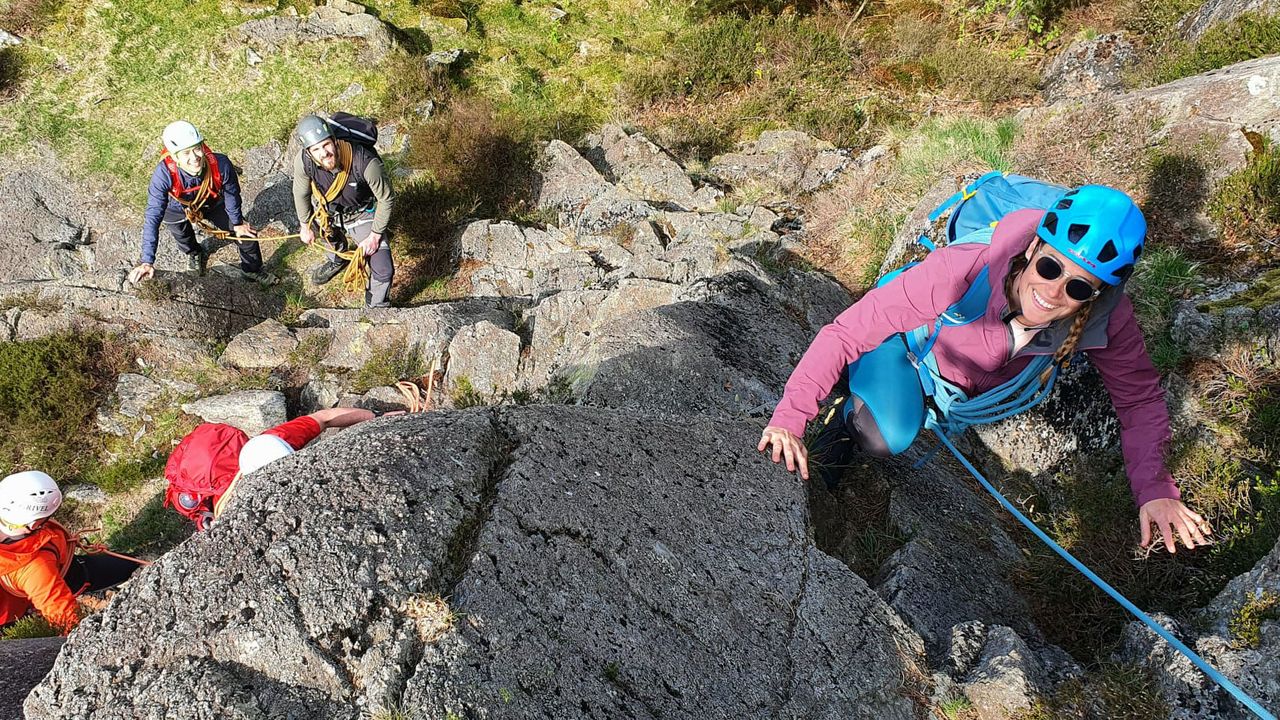
(Image credit: Adrian Nelhams / ISM)
Jump to category:What is scrambling?Scrambling kitWhat is short roping?Roped scrambling kitBasic principlesMistakes to avoid
Jump to category:What is scrambling?Scrambling kitWhat is short roping?Roped scrambling kitBasic principlesMistakes to avoid
In hiking terms, scrambling is kind of a mid-point between walking and climbing. It involves tackling the kind of steeper, rockier ground that requires use of your hands as well as your feet, but isn’t steep or treacherous enough to require you to be fully roped up and putting protection into the wall. There are, however, situations where you might want to use a rope for scrambling – we’ll get into that later in the article.
For those who enjoy hiking, taking on a scrambling route can be a logical next step up, offering a greater challenge and allowing you to tackle more varied routes without having to invest in a bunch more kit. It’s also, in my opinion, loads more fun than regular hiking.
What is scrambling?
“Scrambling is that sort of terrain where it’s not necessarily rock climbing, and it’s not walking,” explains Adrian. “It’s that kind of broken, moderate terrain that you might have to use your hands to get over, or it might be small steps. It’s that sort of in-between ground.”
What kit do you need for scrambling?
Hiking boots
For regular scrambling, you don’t need any kit beyond what you’d take on a hike. You should, however, make sure you’re wearing the right shoes on. Adrian recommends looking for something with a heel, and support around the ankle. Which in essence means a boot. “It’s really key to have the right footwear in the mountains,” he says. “A walking boot has a heel which means going downhill there’s a bit more grip on the descent.”
Check our guides to thebest hiking boots for menand thebest hiking boots for womenfor our recommendations (I wore theArc’teryx Aerios FL Mid GTX, which sits somewhere between a shoe and a boot, for my scrambling session, and they performed extremely well).
Sign up to the T3 newsletter for smarter living straight to your inbox
Get all the latest news, reviews, deals and buying guides on gorgeous tech, home and active products from the T3 experts
(Image credit: Future)
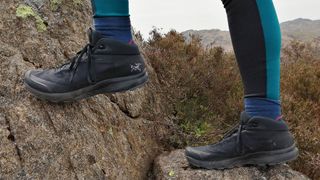
(Image credit: Future)
Another option, in some cases, is to go for anapproach shoe. Adrian says as a climber there are often situations where you’re tackling varied terrain where some sections require approach shoes and others are less intense, and where you just might not have your walking boots with you. But be aware that approach shoes have their down-sides.
“I’m definitely aware that the approach shoe is not as good as the walking boot – there’s no heel, so as soon as you come down that slightly steeper, grassier slope, it’s a lot slipperier if you don’t have the heel keying in,” he says. “So I’m a bit more cautious. There’s a few approach shoes on the market that have got heels, which makes a massive difference.”
Whatever you do, don’t be tempted to go for a trainer. “Lightweight trainers are just not appropriate; they’re really slippery, there’s no edge to stand on and they feel a lot less secure,” says Adrian.
Helmet
Although it might seem like overkill in some cases, Adrian emphasises the importance of putting on a helmet.
“With any steepening terrain, the first bit of kit you need is a helmet,” he says. “If you’re close to any steep terrain, big cliff or anything like that, you need to be aware of the environment around you. People climbing or scrambling above you, kicking stuff down or dropping something. Or even in the Lakes here, a lot of sheep get on really steep ground, and they’ve only got to knock a stone down or something. Even a really small one, if it comes down 100m and you’re standing at the bottom there [it can do some serious damage]. Get a helmet on nice and early. A helmet is really key.”
What is short roping?
Often, people will solo scrambly terrain – which means tackling it without a rope, just using hands and feet. However, there are some cases where you might want to use a rope.
“Using a rope to cover that terrain just gives the partnership – the two people or three people – a bit more confidence, but certainly a bit more security in moving over it. A lot of walkers move in scrambly terrain because it’s more interesting. They’re not necessarily climbers, but they want to explore maybe a ridge or maybe they want to find a more interesting way to a summit,” says Adrian. “[Soloing it] is okay but if somebody does take a trip or a slip, there’s no way of stopping or arresting that.” For roped scrambling, you use a technique known as short roping.
What is short roping?
“Short roping is the generic term for two or three people moving together, joined to a rope,” explains Adrian. They will rope up, have a reservoir of rope as coils looped around them and a short length of rope between them. They’ll use that to add security as they move over broken, rocky terrain, either in small steps moving together or in short pitches.
(Image credit: Adrian Nelhams / ISM)
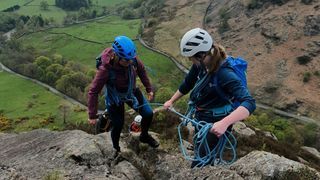
(Image credit: Adrian Nelhams / ISM)
What kit do you need for roped scrambling?
Rope
A 30-40m single rope will provide plenty of rope for a scrambling session. A single rope is one which can be used on its own, as opposed to two thin half ropes, which need to use together if you want to go climbing with them. Adrian suggests looking for a rope that isn’t too thin or too fat, so you can hold it comfortably in your hand and manage well for short-roping.
In terms of the length, you won’t be using the whole 30-40m at any time, so you’ll put it around you as coils. Similarly, if you’re a climber and have 50m rope, don’t cut it down just for a roped scrambling session – just add some coils, and perhaps split them between the two of you.
A harness
“Obviously if you’re going to go scrambling with the intention of using a rope, it’s ideal to have a harness, so you can then attach the rope to the harness really easily,” says Adrian.
Screwgate carabiners and slings
Finally, on to the extras. “You also want a couple of screwgate carabiners, and a couple of slings. Slings are nylon tapes, maybe a couple of metres long, that you could put round a tree to give you an anchor or put over a block or a flake, to help with that security.”
What are the basic principles of roped scrambling?
You rope up in a way that the person in front has in one hand you the reservoir of rope, and then in the other hand, you hold onto the rope. You want to make sure that you can always hold the other person’s weight if they slip. Then you need to think about the kind of terrain you’re working with, and adjust your approach based on whether it’s flat-ish, steep, or really steep.
What do you do on steep ground?
On steep ground, you don’t want to both be moving at the same time.“So you stop, then the person leading the scramble moves over it, and then the other person comes up and joins them. It’s one person moving at any one time, and the first person wants to keep the rope tight so there’s that security there if the partner slips,” explains Adrian.
Don’t move together over steep ground(Image credit: Future)
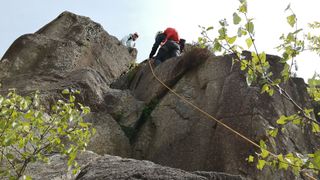
Don’t move together over steep ground
Don’t move together over steep ground
(Image credit: Future)
What do you do on flat ground?
When the ground is flatter and a slip isn’t going to really do any damage, it’s fine to just walk it normally, moving together at the same time.
And what about really, really steep ground?
In situations where the lead person is going to need both hands and feet to get up a section safely, and in which there’s going to end up being a big gap between the two scramblers when the first has reached a flat, safe section, a different approach is required. The person in front needs to drop the rope, make their way up the long, steep section, and then make it safe for the second person to tackle it.
“You don’t want to just stand there and hold the rope because you’re now far away from your partner and you won’t be able to hold them securely. If they tumble or even fall, there’s no way you’re going to be able to hold that physically,” explains Adrian. Look for a solid block or spike to put your rope around, or use a sling around a tree; something to give some extra security.
On very steep ground, you might need to add some extra security(Image credit: Future)

On very steep ground, you might need to add some extra security
On very steep ground, you might need to add some extra security
(Image credit: Future)
What are the common mistakes people make?
Not communicating properly
When you’re first starting out with roped scrambling, communication is all important, which means a bit of role play. “Tell the person you’re short roping when to slow down, telling them to stop, telling them to wait there, telling them to make sure they feed the rope out as you’re climbing up to make sure that it doesn’t catch on anything,” says Adrian.
You want to avoid situations where the second person is following the first too closely, and the leader can’t take in the rope efficiently. If you end up with slack in the rope between you, the whole process breaks down.
“It’s a bit hard for some people with that whole role playing thing, but it’s important,” he continues. “Then once you’ve done 100m, 200m, 300m, you kind of understand each other a bit more and then your partner will know to stop, because they don’t want to be moving until the rope comes tight, or you turn around you’ve got the rope, and then you kind of move on again.”
Misjudging the terrain
One major mistake is to try and move together on steeper ground, when really you need to be tackling it separately. “That takes a lot of judgement,” says Adrian. “I train mountain guides up in the Alps and the thing that takes the most experience and the most time is judging the terrain that you’re on.”
As the lead person is bringing the second person towards them over a step, they need to be making a plan for how to tackle the next section. “I think, do I get them to stop there? Or can we move together over this next section? It’s judging the terrain so you’re using the right technique. Do we just walk together? Do we short step? Do we do a short pitch? Or do I take some coils off, dump them all on the ground, get my partner to belay me as if I was climbing, and then turn it into more of a climbing pitch? It’s just judging the terrain so you can move… really efficiently, doing what’s necessary for the terrain that you’re on.”
Moving fast on wet ground
On final potential hazard is not making necessary adjustments when the terrain is wet. “If the rock is wet then obviously there’s an element there that makes the scrambling a bit more difficult, it’s more slippery, it’s less secure,” says Adrian. “You need to think about maybe using blocks or the terrain a bit more than you would do if it was dry. And if it’s wet rock then you might be using anchors more than if it was dry rock.”

This E Ink notebook can replace your Kindle and Chromebook in oneBOOX’s new E Ink tablet can turn into an Android-powered laptop too
BOOX’s new E Ink tablet can turn into an Android-powered laptop too

Sky Stream gets a great new trick that unlocks long hidden potentialA Sky Stream puck update gives you a host of new channels
A Sky Stream puck update gives you a host of new channels

Change my mind: the smaller, the better with portable power stationsPut your portable power station to work when you’re not using it
Put your portable power station to work when you’re not using it

This rugged adventure Garmin is mega cheap in Walmart’s Black Friday saleThe Instinct 2 is a top watch for outdoor and sport enthusiasts
The Instinct 2 is a top watch for outdoor and sport enthusiasts

YETI’s best-selling products are ridiculously cheap in Amazon’s Black Friday saleFancy yourself a tumbler, rambler or cooler? Amazon’s reduced them all
Fancy yourself a tumbler, rambler or cooler? Amazon’s reduced them all

Knee pain when hiking? Try these four helpful hacks from a strength coachThere’s no need to hang up your hiking boots just yet
There’s no need to hang up your hiking boots just yet

Feeling cold on your winter hike? An outdoor expert says you’re making this mistakeApparently it’s common with ‘first-time hikers’
Apparently it’s common with ‘first-time hikers’

5 gadgets you need for your fastpacking adventure, according to an outdoor expertIf you aren’t taking these out for a fastpack, then it’s time too!
If you aren’t taking these out for a fastpack, then it’s time too!

What’s fastpacking: the adventure sport that lets you go further, faster, and lighter on the trailsTrail running meets backpacking for one epic adventure
Trail running meets backpacking for one epic adventure
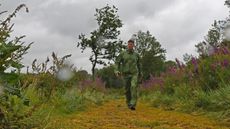
Columbia Wyldwood Waterproof Hiking Shell review: the most waterproof (and shiny) jacket I’ve ever wornIt might not have the matt finish most people expect from a jacket, but the Wyldwood really shines when it comes to protecting you from wet and windy weather
It might not have the matt finish most people expect from a jacket, but the Wyldwood really shines when it comes to protecting you from wet and windy weather